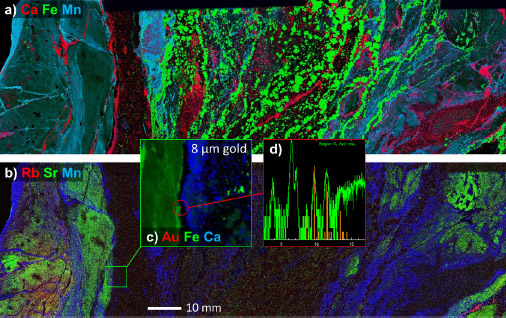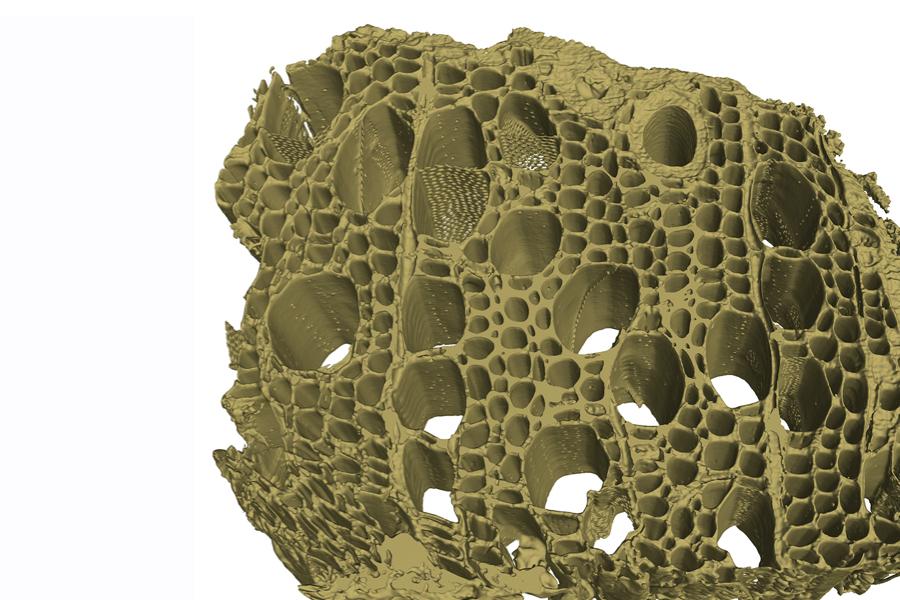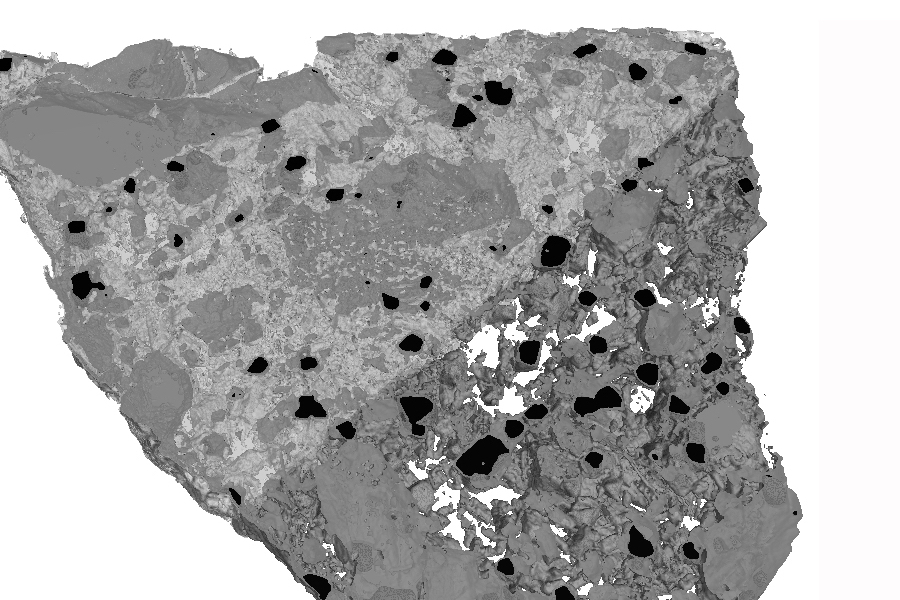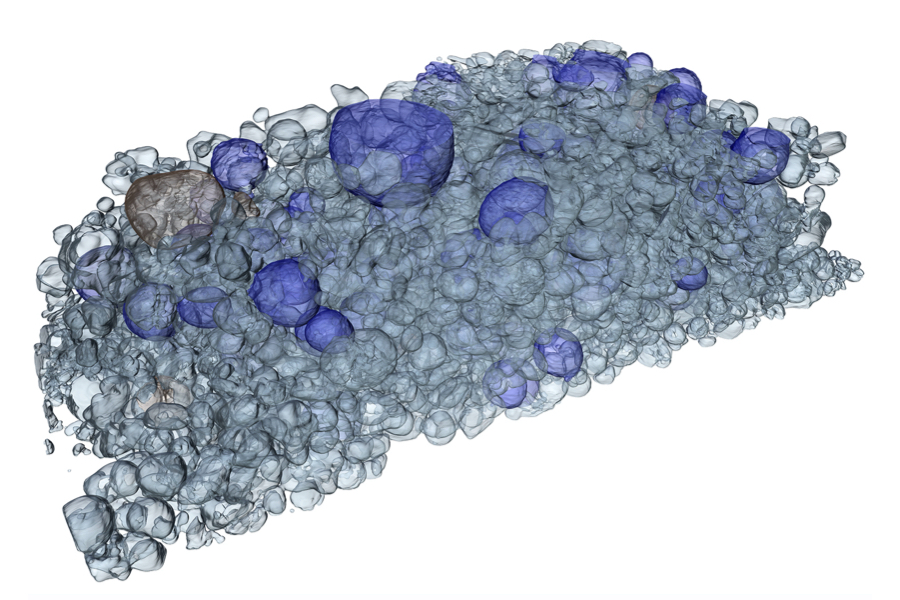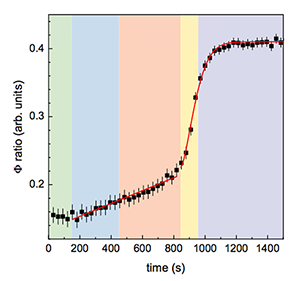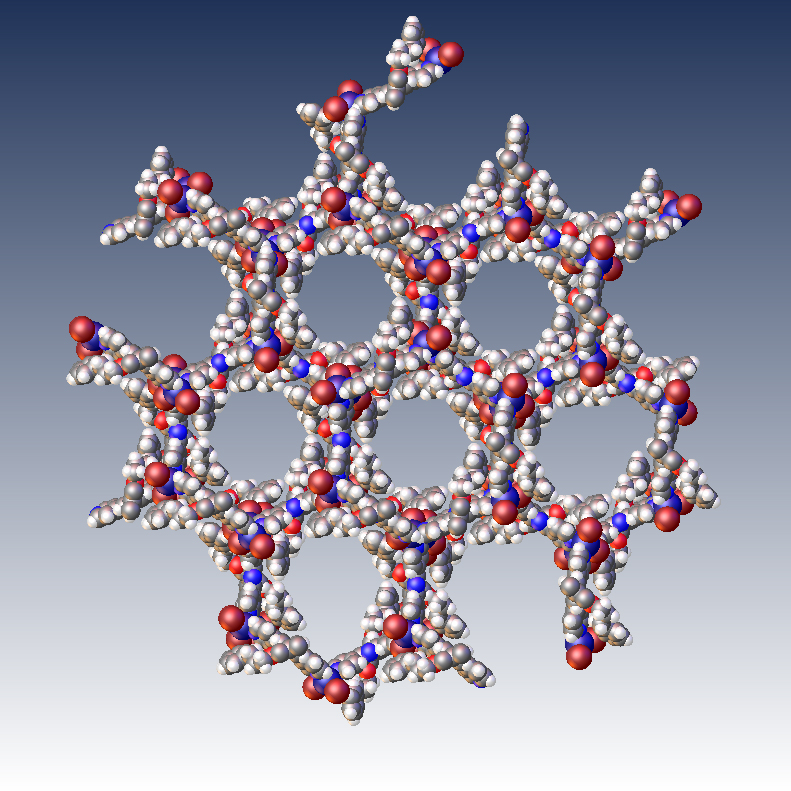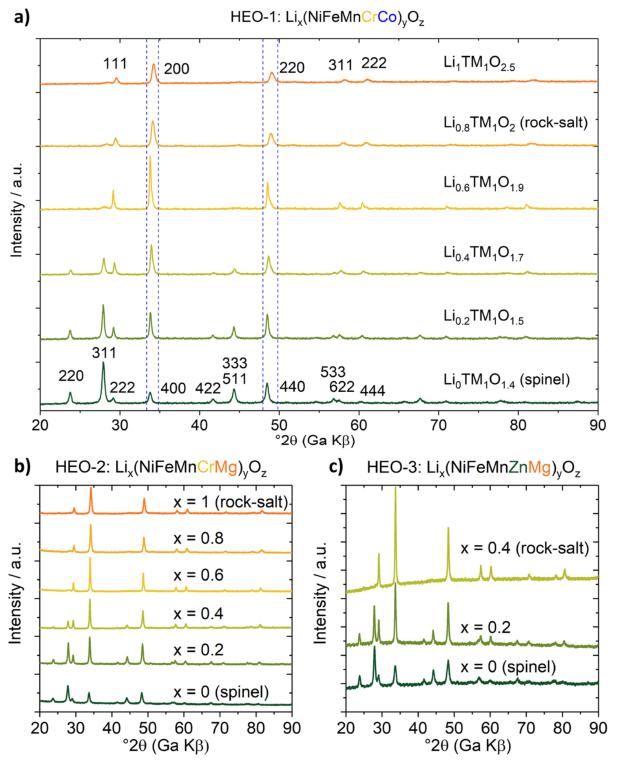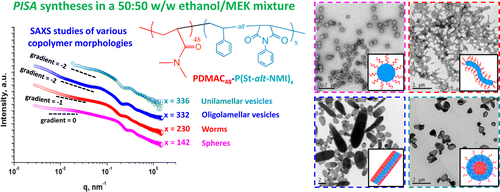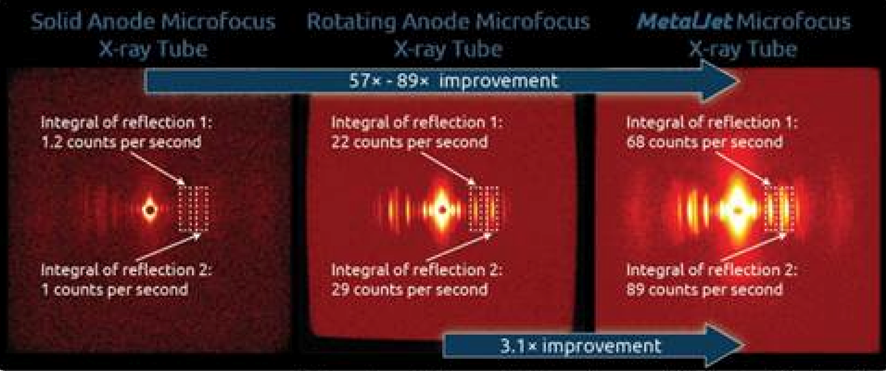Materials science
Scientists use a wide range of methods in their quest for new materials. For more than a century, X-ray techniques have been established as key to acquiring better understanding of a material’s micro- and macrostructure, composition, and chemistry. Such techniques include diffraction (XRD) and scattering (SAXS), spectroscopy (XRF, XPS, XES, etc.) and imaging (radiography, CT, diffraction imaging). Yet as materials become more advanced, higher demands are being placed on these techniques to resolve the parameters of interest. The higher brightness of Excillum X-ray sources gives researchers increased throughput and better signal-to-noise ratio. Higher energy X-rays also improve transmission through samples of varying densities. And for the most demanding X-ray imaging applications, micrometer or nanometer-level X-ray spots offer higher resolution for a wide range of microscopic features that were previously impossible to accurately capture.
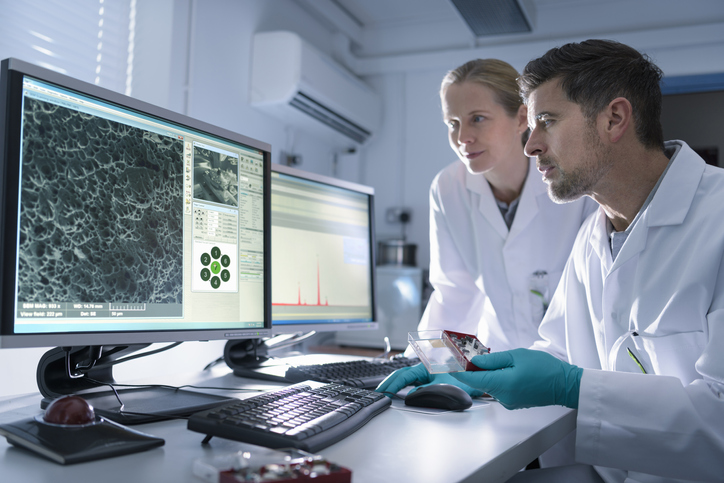
Application examples
Drill core analysis
A drill core from the Jundee gold mine imaged with the Maia Mapper showing the combination of large field of view (231×46 mm2) and high resolution (30 µm pixel size) within decent acquisition times (6.0 ms dwell). The RGB images are shown here as Ca-Fe-Mn (a) and Rb-Sr-Mn (b), the inset from Au-Fe-Ca image highlights the details within the region with a rare grain and the spectrum thereupon. C.G. Ryan, et al., “Maia Mapper: high definition XRF imaging in the lab”, J. Instrum. (2018).
NanoCT for geological and raw materials characterization
A NanoCT system with the Excillum NanoTube has been designed, developed and commissioned at Fraunhofer IIS, Würzburg, Germany. Together with an EIGER2 CdTe detector, the system has been optimized for materials characterization and NDT applications.
3D rendering of the phase-contrast NanoCT of an alder wood sample, revealing the inner microstructure of the wood in high resolution. Voxel sampling 300 nm.
3D rendering of the phase-contrast Nano-CT of a basalt sample, revealing the different phases, elements and structures help geologists to further understand this sample. Voxel sampling 350 nm.
Battery materials research
The video below shows a NanoCT of a lithium ion battery cathode material, where the microsctructure of the material can be clearly resolved. Both the aluminum cathode collector and the active LiCoO2 layer are visualized and can be analyzed further thanks to the high resolution enabled by the small X-ray spot of the Excillum NanoTube N3.
These results were generated at the applications lab at Excillum in Sweden, using our NanoTube N3 and a detector from Dectris. Visualization and analysis was made using ORS Dragonfly.
In the image below, a 3D rendering of the NanoCT of a lithium ion battery cathode (NCA/LCO-E) shows particles of different sizes. Voxel sampling 140 nm.
This NanoCT system with the Excillum NanoTube has been designed, developed and commissioned at Fraunhofer IIS, Würzburg, Germany. Together with an EIGER2 CdTe detector, the system has been optimized for materials characterization and NDT applications.
Performance improvements of solar cells
In the laboratory at Meiji University, led by Professor Atsushi Ogura, the objective is to improve the performance of solar cells and electronics devices based on semiconductor nanotechnology. A significant improvement in material characterization capability was achieved when a Scienta Omicron HAXPES-Lab system was installed. The HAXPES-Lab is a home laboratory-type hard X-ray photoelectron spectroscopy (HAXPES) system with the key components: monochromator, high energy analyzer and a 9 keV X-ray source, the Excillum MetalJet D2+. The non-destructive technique of HAXPES opens up a window to the bulk, as the technique can characterize the element-specific chemical states sub surface of materials, e.g. at buried interfaces or in the bulk. Previously, 9 keV photoemission had only been possible at synchrotron beamlines but with the introduction of the HAXPES-Lab system experiments in the home laboratory became possible, 24 hours a day, 365 days a year.
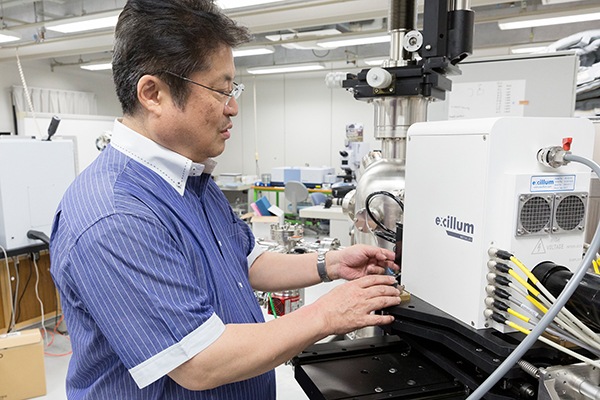
Investigation of bulk heterojunction solar cells
Ratio of assembled versus not assembled polymer-fullerene mixture as calculated from grazing incidence scattering measurements. ACS Applied Materials & Interfaces, 2017, 9, 8241–8247 K. Vegso, P. Siffalovic, M. Jergel, P. Nadazdy, V. Nádaždy, E. Majkova.
GISAXS and GIWAXS are X-ray methods used to give insight into the order and orientation of thin films on a substrate, typical examples include solar cells, long range order of block copolymers, nanoparticles and nanoparticle composites, membranes and lithographic patterning. Using a high intensity X-ray source such as the MetalJet for these experiments enables in-situ investigation of materials. One example of such an in-situ study is that of Vegso at al. from the institute of physics of the Slovak academy of science. They used a laboratory GISAXS/GIWAXS setup with a MetalJet emitting Ga Kα X-ray radiation to investigate the phase separation of the polymer and the fullerene phase in a bulk heterojunction solar cell. The size and intermixing of domains of the electron acceptor (polymer) and the electron donor (fullerene) are key determinants of the efficiency with which solar energy is converted to electrical power. The combination of GISAXS and -WAXS give unprecedented insight into the real-time structural evolution of the polymer:fullerene phase separation in terms of polymer crystallization and fullerene agglomeration. GISAXS patterns were collected with 10 second intervals and GIWAXS patterns with 2.5 second intervals. These short exposures were sufficient to follow the kinetics of the bulk heterojunction formation of the spin-coated polymer: fullerene mixture by means of tracking the ratio of assembled material versus non-assembled material (φ) as depicted in the picture to the right, the radius of gyration (Rg) of the fullerene phase and the d100 spacing of the lamellar polymer phase.
Extended metal network structures
- a = 35.9593(6) Å
- b = 35.9593(6) Å
- c = 25.1227(3) Å
- R1= 8.98%
Challenging high entropy oxide samples
Researcher at Karlsruhe Institute of Technology utilized a STOE Stadi MP goniometer powered by a MetalJet D2+ to investigate challenging high entropy oxide (HEO) samples. The challenge was to measure a large number of samples and that for every type of sample only a small amount was available. By illuminating the powder samples with a focused bright and small beam of quasi monochromatic Gallium K β radiation, a good signal to noise ratio was obtained with an acceptable measurement time. Powder XRD data sets of a HEOs with varying composition are illustrated here. For more details, please see the references: Wang et.al.: Spinel to Rock-Salt Transformation in High Entropy oxides with Li Incorporation. Electrochem 2020, 1, 60–74;doi:10.3390/electrochem1010007 Wang et.al.: Multi-anionic and –cationic compounds: new high entropy materials for advanced Li-ion batteries. Energy Environ. Sci. 2019; doi: 10.1039/c9ee00368a
Polymers
The investigation of polymers is one of the main areas of focus of the Soft Matter Analytical Laboratory (SMALL) at the University of Sheffield. A £2 million infrastructure investment enabled them to purchase a state-of-the-art SAXS instrument with a gallium-based MetalJet X-ray source in 2016. The first publication with their new equipment was a study on the reversible addition–fragmentation chain transfer (RAFT) copolymerization of styrene with N-phenylmaleimide, resulting in the formation of block copolymer nano-objects with a potential application as foam stabilizers. The researchers at SMALL showed that polymerization-induced self-assembly (PISA) of this copolymer gives different morphologies depending on the ratio between the two polymer blocks. In their article, they present a novel synthesis method using a less toxic cosolvent compared to previous studies: methyl ethyl ketone versus the previously used 1,4-dioxane. Transmission electron microscopy (TEM) revealed vesicular morphologies, similar to what was observed in their previous studies with other PISA formulations. Using Small-Angle X-ray Scattering (SAXS) however, they were able to obtain structural information about the internal structure of these vesicles. This way, they found that in the current system they obtain oligolamellar vesicles, whereas the use of a different stabilizer block results in unilamellar platelet-like particles. Furthermore, SAXS confirms the morphology of the self-assembled copolymers (see figure above) and gives access to statistically relevant information about the size and shape of the self-assembled polymer chains. The SAXS instrument, equipped with a liquid gallium MetalJet, was the first of its kind to be installed in the UK. The intensity of the X-rays is about a hundred times higher than what could be achieved with the old SAXS instrument. Dr. Oleksandr Mykhaylyk, the facility manager, says that this enables them to analyze their samples in several minutes, rather than the several hours it took with the old instrument.
Fibers
Fibers are an important component in many natural and man-made materials ranging from clothes to technologically advanced materials like optical fibers. Many natural fibers, such as for example spider silk, are extremely strong and durable. To mimic the properties of this type of materials in synthetic fibers, a thorough understanding of the fiber structure is required. Small-Angle X-ray Scattering (SAXS) provides an excellent means to obtain information on parameters such as porosity, crystallinity, and the size, shape and dispersity of structural units as well as their orientation. Together, these properties dictate the mechanical properties of the fibers. The technique is also well suited to monitor how these properties change during production and under load and stress. Especially for the analysis of very thin fibers and for in situ measurements, a high intensity, low divergence X-ray source is advantageous. The high intensity of the MetalJet X-ray source allows short measurement times, even for weakly scattering fibers. For time resolved measurements, such as tensile stretching or the monitoring of an extrusion process, the high intensity is indispensable. The low divergence of the MetalJet ensures good separation between signals, which in turn gives better defined reflections and allows for more accurate integration of the intensities. The result of a SAXS measurement on a fiber can be seen in the 2D scattering pattern of rat tail tendon above. These thin fibers are a common standard for the calibration of SAXS instruments. Rat tail tendons consist of collagen, which has a primary spacing of about 67 nm and produces a SAXS pattern with equidistant peaks. The above scattering patterns were acquired by application scientists at Bruker AXS using a Nanostar instrument, equipped with an three different X-ray sources: a sealed-tube, solid anode microfocus source, a rotating anode, and an Excillum MetalJet (200W at 70kV). These experiments show that the MetalJet gives an intensity gain of more than 50 times compared to sealed microfocus tubes.
Related user stories
Experiences with the Excillum X-ray sources
Learn about some of our customers' experiences with our state-of-the-art X-ray sources.
